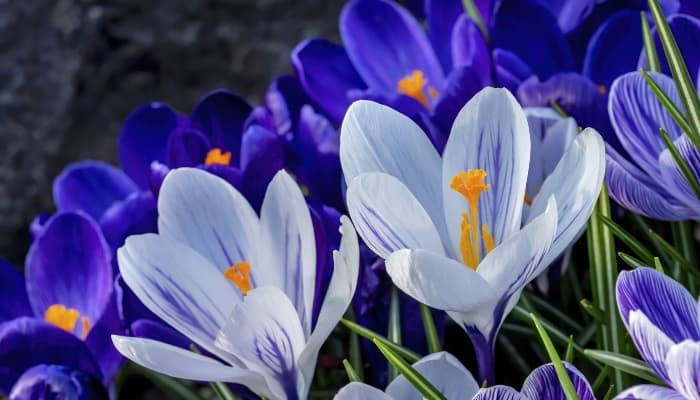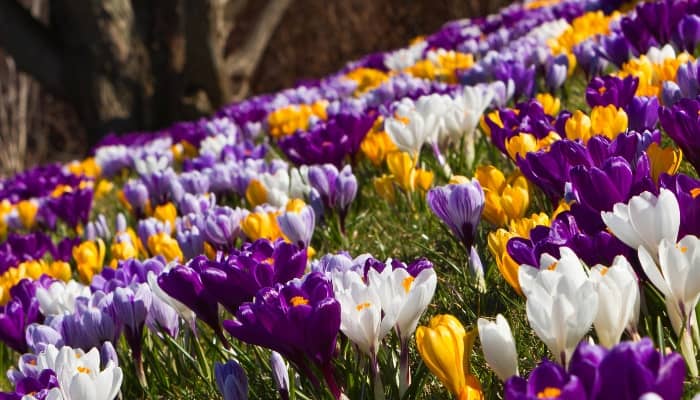Crocuses are among the first plants to blossom in the garden. While each bulb yields only one flower, planting them in clusters can bring vibrant hues to your landscape.
The flowers come in different vibrant colors and stay in bloom for up to 3 weeks.
Crocus thrives in well-draining and loamy soil. Choose a sunny location that gets either full or partial shade. The perennial plant needs neutral pH levels between 6.0 and 7.0 and grows well in Zones 3 to 8. Plant them in the fall before the last frost to enjoy spring blooms.
A single crocus flower can easily disappear in a vast landscape, but a group of crocus bulbs planted in a certain design can bring life and colors to the landscape.
Read more to find out how to grow and care for crocus bulbs.
Guide To Planting Crocus Bulbs
It takes more than just the right type of soil or light conditions to ensure that your crocuses grow, thrive, and blossom.
There’s planting time to consider in addition to feeding and watering among others, but once you get the hang of it, the crocus bulbs will reward your work with delightful flowers to make your garden the envy of the neighborhood.
Crocus Growing Conditions
Unlike other bulbs or ornamental plants you might have come across, the crocus is quite straightforward to grow and doesn’t require special conditions.
Here are the main 4 growing conditions to pay attention to.
Soil
Usually, crocuses won’t have a problem with the soil type. However, I recommend you plant the bulbs in loamy soil. This type of soil has the right texture to retain moisture but it drains well at the same time.
Amend the garden soil with coarse sand to improve drainage, and get the pH levels between 6.0 and 7.0.
Light
Full sun is required for crocuses to bloom in the spring. Choose a spot facing the west or south for the plants to get the most sun throughout the day.
That said, crocuses are early bloomers in the spring when most plants, and even trees, are still barren, so they will get more sun in some spots before the deciduous trees get dense foliage and cast a heavy shadow on them.
Water
Your crocuses will need regular watering in the spring and fall. In the summer, the plants go dormant, so cut back on watering during the summer months.
Try to keep the soil moist in the spring and fall. The plant needs water and nutrients in the fall to store energy in the bulbs for blooms the next spring.
Fertilizer
You’ll need to fertilize the crocuses in the fall, but they don’t need a lot of feeding. The leaves photosynthesize sunlight, and the roots absorb nutrients from the soil.
This plant’s energy is stored in the bulbs, but you can apply a mild fertilizer at half strength or use organic fertilizers such as bone meal. One application is usually enough.
How Many Crocus Bulbs Should You Plant Together?
In general, the more crocus bulbs you plant, the better. One single crocus bulb producing a single flower will hardly be noticed, but if you cover a whole bed with the bulbs, you’ll notice a huge difference in the lawn or garden come springtime.
Usually, you shouldn’t plant less than 10 bulbs together, but you can go as high as 50 divided into small patches.
The only drawback is that the plants tend to multiply, so you wouldn’t want to go overboard with the bulbs. Let nature do that for you!
Do Crocus Spread?
Crocuses tend to spread and multiply readily. In the fall, the plants store energy in the bulbs, which tend to grow additional smaller bulbs for more plants.
These bulbs will sprout in the spring and produce flowers. You can also multiply the plant through division.
Crocus Planting Ideas
- As early bloomers, you can plant crocus bulbs in areas that get partial sunlight in the summer. Most flowering plants won’t thrive in the shade of a deciduous tree or other tall plants, but crocuses will.
- Even after the blooms have faded, the plant retains its foliage, so it still has ornamental values at least three seasons out of four.
- Plant crocuses in rock gardens or add them to other bulbs, such as daffodils and tulips, in the garden.
- Consider planting them with flowers that will bloom later in contrasting colors for an ever-changing effect.
- It’s an excellent choice for borders since it’s a perennial plant.
- Mix it with late-blooming varieties to enjoy a long bloom season.

Planting Crocus Bulbs in Lawn
If your lawn already has turf, you can simply lift the turf and prepare the soil for the crocus bulbs.
- Turn up the top 10 inches of the soil, and add organic compost or homemade fertilizers.
- Mix well, and allow the soil to sit under the sun for a week before planting the bulbs.
- Crocuses spread, so you’ll need to divide them every 2 to 3 years to manage them in the lawn.
When To Plant Crocus
The best time to plant crocuses is in the fall. Allow between 6 and 8 weeks before the first frost to give the plants a chance to develop roots before the cold winter.
In the spring, the plants will come out of dormancy and flower.
How Deep To Plant Crocus Bulbs
When planting a crocus bulb, dig a hole 3 to 4 inches deep. The flat bottom of the bulb should rest on the soil with the pointy end up. Cover the hole with soil, and pack it firmly to push out air pockets.
When Do Crocuses Bloom?
Crocuses are early bloomers, but the time of bloom depends on many factors including the variety, weather, and whether they had chill hours the previous winter or not.
Many crocus varieties bloom in the early spring before any other flowering plants, but some will start blooming in the late winter.
Can You Leave Crocus Bulbs in the Ground All Year?
If you’re sure that the soil in the garden drains well and is not likely to retain water or stay wet for days on end, then you can leave the bulbs in the ground.
The hardy bulbs need cold weather in the winter, but if the soil gets soggy, especially with heavy rainfall, they could rot. In that case, you’ll need to dig them up and plant them again in the fall.
What To Plant With Crocus
Crocuses do well with other bulbs such as tulips and daffodils. Hazel, Asian jasmine, and forsythia are also good companions.
How To Plant Bulbs and Perennials Together
Perennials can help you locate where the bulbs are, so always plant perennials right in front of the bulbs to avoid accidental damage to the bulbs.
Related Questions:
How Late Can Crocus Be Planted?
For spring bloomers, plant the bulbs from September to November. If you want them to bloom in the fall or winter, plant the bulbs in the late summer.
When To Plant Crocus Bulbs in Pots?
Potted crocus bulbs can be planted in the fall from September to November.
Conclusion
Crocuses are ornamental plants that flower early in the spring with some varieties that bloom in the late winter. They require full sun, but you can also plant them under deciduous trees.

